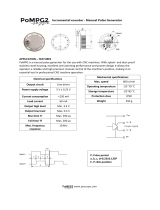
Hardware configuration.
CNCelite
8058 8060
8065 8070
ꞏ4ꞏ
REF: 2104
4.9.3 Connecting the USB2.0 port. .................................................................................... 77
4.9.4 Feedback connection................................................................................................. 78
4.9.5 Handwheel connection (only QC-C##-10K). .............................................................. 79
4.9.6 Probe connection. ...................................................................................................... 81
4.9.7 Connection to an Ethernet network............................................................................ 84
4.9.8 EtherCAT bus. .......................................................................................................... 85
4.9.9 CAN bus..................................................................................................................... 88
4.9.10 Sercos III bus. ........................................................................................................... 91
CHAPTER 5 CENTRAL UNIT (IN-CABINET MODEL WITH POSSIBILITY OF VESA MOUNTING).
5.1 Specifications. ............................................................................................................... 94
5.2 Dimensions. .................................................................................................................. 96
5.3 Enclosure and securing of the modules......................................................................... 97
5.3.1 Ambient characteristics of the cabinet. ...................................................................... 97
5.3.2 Cabinet design. .......................................................................................................... 97
5.3.3 Ventilation. ................................................................................................................. 97
5.4 VESA mount. .................................................................................................................98
5.5 Power supply for the module. ....................................................................................... 99
5.5.1 Central unit electrical features. .................................................................................. 99
5.5.2 Protection against over-voltage and reverse voltage................................................. 99
5.5.3 Voltage supply at 24 V DC......................................................................................... 99
5.5.4 Power supply via UPS. ............................................................................................ 100
5.5.5 Ground connection................................................................................................... 100
5.5.6 Specs of the power supply....................................................................................... 100
5.5.7 NOT recommended circuits. .................................................................................... 101
5.6 Non-volatile RAM (FRAM). .......................................................................................... 102
5.7 Hardware functionality (connectors). ........................................................................... 103
5.7.1 Front. ....................................................................................................................... 103
5.7.2 Top. ......................................................................................................................... 104
5.7.3 Bottom. .................................................................................................................... 104
5.7.4 Connector identification. ......................................................................................... 105
5.8 Technical/electrical characteristics of the inputs and outputs. ..................................... 113
5.8.1 Digital inputs. ........................................................................................................... 113
5.8.2 Digital outputs. ......................................................................................................... 113
5.8.3 Analog outputs. ........................................................................................................ 113
5.8.4 Feedback inputs....................................................................................................... 114
5.9 Connections................................................................................................................. 116
5.9.1 Ground connection. ................................................................................................. 116
5.9.2 Connecting the USB2.0 port. .................................................................................. 116
5.9.3 Connecting the DVI-D video output. ........................................................................ 117
5.9.4 Connecting the relay for the emergency chain. ....................................................... 117
5.9.5 Feedback connection............................................................................................... 118
5.9.6 Probe connection. .................................................................................................... 119
5.9.7 Connection to an Ethernet network.......................................................................... 122
5.9.8 EtherCAT bus. ........................................................................................................ 123
5.9.9 Bus Sercos-III. ........................................................................................................ 126
5.9.10 CAN bus................................................................................................................... 128
CHAPTER 6 MONITOR-18 MULTITOUCH.
1.1 Specifications............................................................................................................... 132
1.2 General diagram. ......................................................................................................... 133
1.3 Dimensions. ................................................................................................................ 134
1.4 Enclosure and mounting of the module. ...................................................................... 135
1.4.1 Enclosure design. .................................................................................................... 135
1.4.2 Securing the module. ............................................................................................... 136
1.5 Voltage supply for the module. .................................................................................... 138
1.6 Configuring the video signal from the monitor. ............................................................ 139
1.7 Connectors. ................................................................................................................ 140
1.8 Cable characteristics. .................................................................................................. 143
1.8.1 VGA video signal. .................................................................................................... 143
1.8.2 DVI-D video signal. ................................................................................................. 144
1.9 OSD (On Screen Display) menu.................................................................................. 145
1.9.1 Using the rear keyboard with the OSD menu. ......................................................... 145
1.9.2 OSD menu. .............................................................................................................. 146
1.9.3 Locks and unlocks the OSD menu........................................................................... 151
CHAPTER 7 MONITOR-21 MULTITOUCH.
7.1 Specifications............................................................................................................... 154
7.2 General diagram. ........................................................................................................ 155
7.3 Dimensions. ................................................................................................................ 156
7.4 Enclosure and mounting of the module. ...................................................................... 157




















